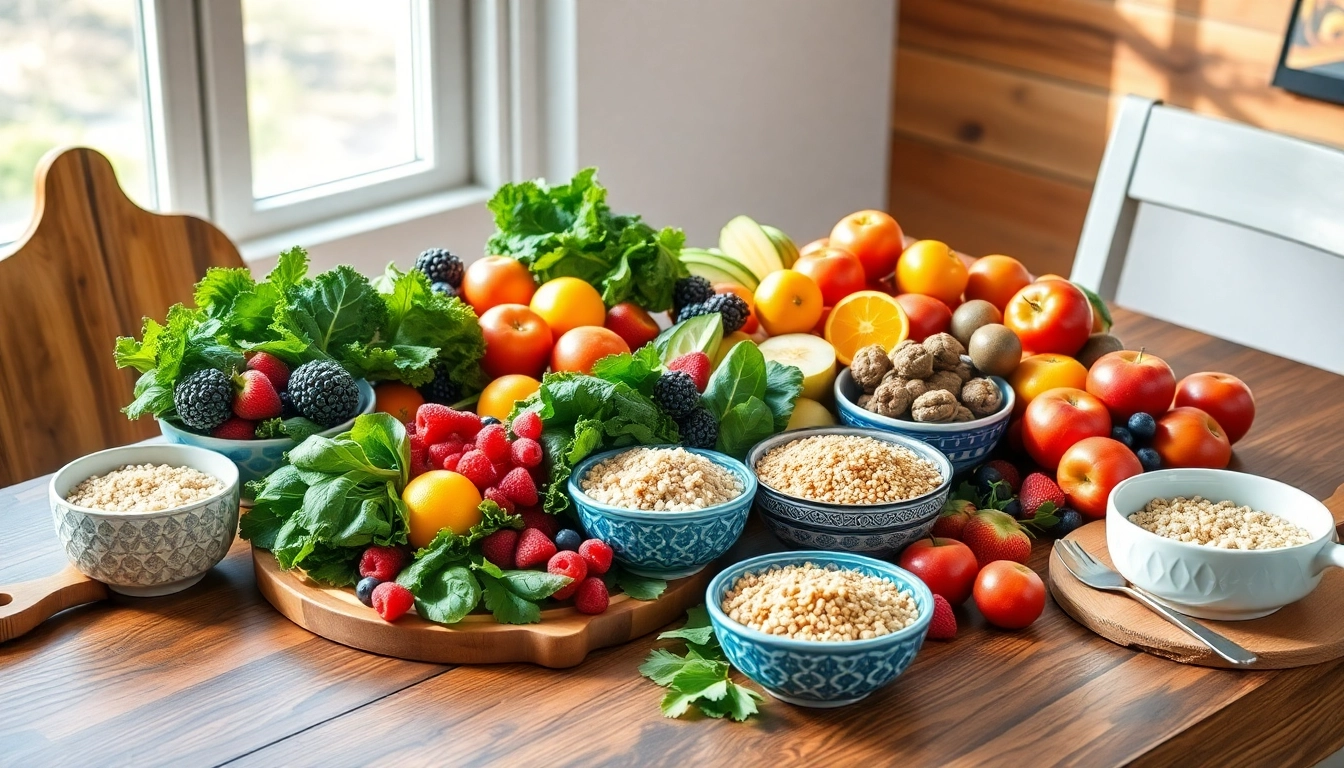Essential Healthy Food Choices: Complete Guide for 2024

Understanding the Importance of Healthy Food
In today’s fast-paced world, the significance of healthy food cannot be overstated. As lifestyles become increasingly hectic, many individuals turn to convenience foods, often at the expense of nutrition. Choosing healthy food options is essential for maintaining overall well-being and preventing chronic diseases. The journey to a healthier lifestyle begins with a deeper understanding of what makes food healthy and the profound impact it can have on our physical and mental health.
What Defines Healthy Food?
Healthy food refers to foods that are nutrient-dense, meaning they are rich in essential nutrients with relatively few calories. These foods are typically low in added sugars, unhealthy fats, and sodium. The following categories of food are generally considered healthy:
- Fruits and Vegetables: A variety of colors and types provide different vitamins, minerals, and antioxidants.
- Whole Grains: Foods like brown rice, quinoa, and whole-grain bread are high in fiber and nutrients.
- Lean Proteins: Sources such as chicken, fish, legumes, and nuts offer essential amino acids without excessive fat.
- Dairy or Dairy Alternatives: Options like low-fat milk or fortified plant-based milks can provide calcium and vitamin D.
- Healthy Fats: Incorporate sources of good fats like avocados, olive oil, and nuts to support heart health.
The Impact of Healthy Food on Well-being
The foods we consume have a direct correlation with our health. Regular consumption of healthy foods can lead to numerous benefits:
- Weight Management: Nutrient-dense foods help maintain a healthy weight by keeping you full longer.
- Reduced Risk of Chronic Diseases: Diets rich in fruits, vegetables, and whole grains can lower the risk of heart disease, diabetes, and certain cancers.
- Improved Mental Health: Nutrition affects neurotransmitter function, which influences mood and cognitive function.
- Enhanced Energy Levels: Whole foods provide consistent energy, as they are digested more slowly compared to refined foods, preventing energy spikes and crashes.
Common Misconceptions about Healthy Eating
Despite the plethora of information available, several misconceptions about healthy eating persist:
- You Have to Eat Tasteless Food: Many believe that healthy foods lack flavor. In reality, a nutritious diet can be delicious with the right spices and cooking methods.
- Healthy Eating is Expensive: While some health foods can be costly, many affordable options like canned beans, seasonal fruits, and local vegetables provide substantial nutrition.
- All Fats are Bad: Understanding the difference between unhealthy trans fats and healthy fats is crucial. Healthy fats are vital for hormone production and nutrient absorption.
Top 10 Healthy Foods You Should Include Daily
Including a variety of food in your daily diet can significantly improve your health. Here are ten essential foods to consider integrating into your meals:
Fruits: Nature’s Sweet Treats
Rich in vitamins, minerals, and fiber, fruits are an essential part of a healthy diet. Berries, apples, bananas, and oranges are not only delicious but also offer antioxidant properties that help combat oxidative stress.
- Blueberries: Known for their high antioxidant content, they can boost brain health.
- Bananas: A great source of potassium, which helps regulate blood pressure.
- Citrus Fruits: Oranges and lemons are rich in vitamin C, supporting immune health.
Vegetables: Color Your Plate
Vegetables provide a variety of essential nutrients and should make up a substantial part of your diet. Dark leafy greens, cruciferous vegetables, and root vegetables all offer unique health benefits.
- Kale: Packed with vitamins A, C, and K and known for its anti-inflammatory properties.
- Broccoli: Contains compounds that may protect against cancer and support heart health.
- Carrots: Rich in beta-carotene, promoting skin health and good vision.
Whole Grains: The Fiber-Packed Powerhouses
Whole grains retain the bran and germ during processing, providing more vitamins and minerals than their refined counterparts. Regular consumption can aid digestion and reduce the risk of heart disease.
- Quinoa: A complete protein, it contains all nine essential amino acids.
- Brown Rice: Offers more nutrients than white rice, including fiber and magnesium.
- Oats: Known for their heart-healthy properties, they can help lower cholesterol levels.
Healthy Food Recipes for Every Meal
Incorporating healthy foods into your diet can be easily achieved through delicious recipes that inspire creativity in the kitchen.
Quick Breakfast Ideas for Busy Mornings
Breakfast is often referred to as the most important meal of the day. Here are quick and healthy breakfast options:
- Overnight Oats: Combine rolled oats, Greek yogurt, chia seeds, and your favorite fruits for a nutritious start.
- Green Smoothies: Blend spinach, banana, a spoonful of nut butter, and almond milk for an energizing drink.
- Avocado Toast: Top whole-grain bread with smashed avocado, a sprinkle of salt, and chili flakes for a filling breakfast.
Nutritious Lunch Options that Energize
Lunchtime is the perfect opportunity to refuel and maintain energy levels. Here are some healthy lunch ideas:
- Quinoa Salad: Mix quinoa with roasted veggies, chickpeas, and a tangy vinaigrette for a refreshing meal.
- Whole Grain Wrap: Fill a whole grain wrap with turkey, spinach, and hummus for a balanced lunch.
- Lentil Soup: A hearty, fiber-rich soup that can be prepared in bulk and enjoyed throughout the week.
Wholesome Dinner Recipes to End Your Day Right
Ending your day with a nutritious meal is necessary for recovery and preparing for the next day. Here are wholesome dinner options:
- Grilled Salmon: Rich in omega-3 fatty acids, serve it with steamed broccoli and quinoa for a balanced dinner.
- Stuffed Bell Peppers: Fill bell peppers with brown rice, ground turkey, black beans, and spices for a satisfying meal.
- Vegetable Stir-Fry: A mix of colorful vegetables stir-fried with tofu or chicken over brown rice creates a nutritious dish.
How to Make Healthy Food Choices Easy
Making healthier food choices doesn’t have to be a struggle. With the right strategies, you can simplify your path to nutritious eating.
Grocery Shopping Tips for Fresh Ingredients
Shopping for groceries can set the tone for your health choices. Here are tips to ensure you choose fresh, healthy options:
- Shop the Perimeter: Most healthy foods are located on the perimeter of the grocery store, where fresh produce, dairy, and meats are found.
- Make a List: Planning your meals and creating a shopping list helps avoid impulse purchases of unhealthy items.
- Embrace Seasonal Produce: Seasonal fruits and vegetables are often fresher, more flavorful, and more affordable.
Meal Prep Strategies to Save Time
Planning and preparing meals in advance can save time and guarantee that you have healthy options ready to go:
- Batch Cooking: Prepare large portions of meals and freeze them for busy days.
- Pre-Cut Vegetables: Spend time prepping vegetables for the week ahead for quick access.
- Use Mason Jars: For salads and overnight oats, layer ingredients properly in jars for easy grab-and-go meals.
Utilizing Seasonal Produce for Better Nutrition
Eating with the seasons not only enhances the flavor of your meals but also increases nutritional value:
- Spring: Enjoy asparagus, strawberries, and peas, which are rich in vitamins and antioxidants.
- Summer: Tomatoes, zucchini, and berries are abundant and can be used in various recipes.
- Fall: Squash, apples, and Brussels sprouts can be roasted for hearty, warming dishes.
- Winter: Root vegetables and citrus fruits provide necessary nutrients during colder months.
Maintaining a Healthy Food Lifestyle Long-term
Successfully adopting a healthy food lifestyle requires commitment and thoughtful strategies to ensure sustainability.
Building Consistent Eating Habits
Consistency is key when it comes to healthy eating. Here are tips to help build strong eating habits:
- Set Realistic Goals: Start with small, achievable goals – like incorporating one additional serving of vegetables each day.
- Practice Mindful Eating: Take time to savor each meal to enhance your relationship with food.
- Keep a Food Journal: Track your meals to identify patterns and areas for improvement.
Adapting Healthy Food Choices When Dining Out
Eating out doesn’t have to derail your healthy eating goals. Consider these strategies to make better choices:
- Check Menus in Advance: Look for healthy options before you go to avoid impulse choices.
- Modify Your Order: Request dressings or sauces on the side and opt for grilled or steamed options.
- Share or Take Home Leftovers: Portion control can be achieved by sharing dishes or asking for half portions.
Tracking Your Progress and Staying Motivated
Tracking your progress can keep you motivated on your path to healthy eating. Here’s how:
- Use Apps: Nutrition and fitness apps can help monitor your meals and physical activities.
- Set Monthly Check-Ins: Regularly evaluate your eating habits and set new goals to continue your progress.
- Celebrate Small Wins: Acknowledge and reward yourself for achieving healthy milestones.



